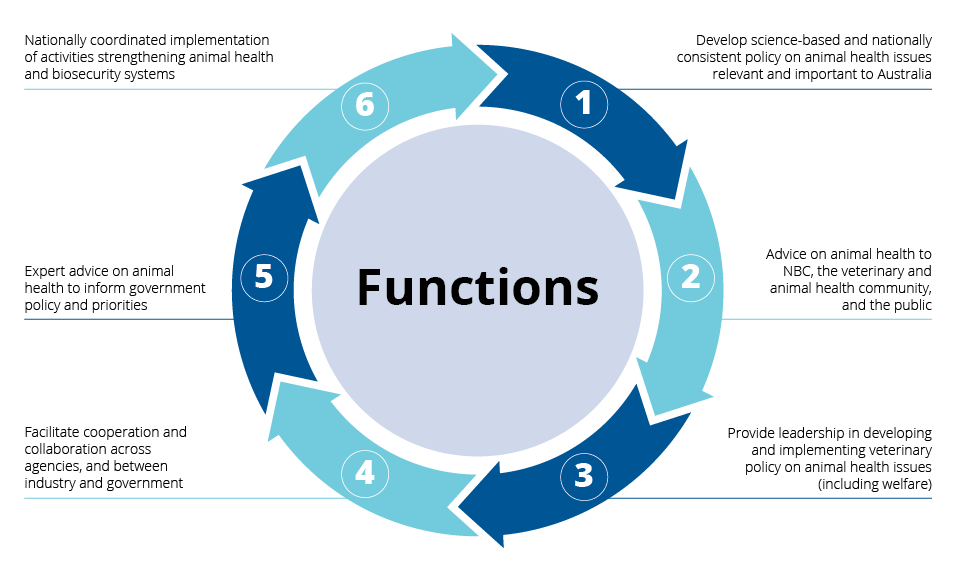AHC provides strategic scientific and policy advice to Australian governments on animal biosecurity through National Biosecurity Committee (NBC), senior officials and ministers, and prioritises and coordinates national animal biosecurity activities by:
- Coordinating the implementation of national animal biosecurity policies, programs and strategies.
- Delivering against priority areas as determined and/or tasked by NBC, including policy areas outlined in the Intergovernmental Agreement on Biosecurity (IGAB).
- Driving development of nationally consistent policies, programs and strategies on animal biosecurity that are based on sound science and risk analysis.
- Establishing standards and coordinating the effective delivery of national animal biosecurity programs and activities across governments and industries.
- Coordinating a regulatory framework for domestic trade in livestock and their products consistent with Australia’s international obligations and principles for interstate trade.
- Advising on new and existing policy issues; including emerging threats, innovations and challenges, and those arising from the implementation of the Emergency Animal Disease Response Agreement and other policies and programs.
- Reviewing and advising on animal biosecurity research, development and extension programs and activities to achieve optimal value from government and industry investment.
- Engaging stakeholders in the strategic planning, policy development and implementation of government processes.
- Collaborating with state and territory departments of primary industries, Animal Health Australia (AHA), sectoral committees and other bodies on relevant issues to ensure alignment, effective liaison and complementary work programs.
- Identifying relevant capabilities and resource requirements for delivering strategic objectives for animal biosecurity.
- Providing annual work plans and regular reporting, including referral of any issues requiring consideration, to NBC in accordance with NBC directives.
Why AHC’s work is so important
Australia enjoys a high level of food quality and an enviable reputation amongst our agricultural trading partners for animal health. Surveillance monitoring and reporting systems focus on the fact that Australia can be called upon to substantiate claims of freedom from certain animal diseases, such as bovine spongiform encephalopathy (BSE). As part of such assurances, Australia must be able to demonstrate that an adequate level of service exists to detect, diagnose and control animal diseases.
Current and recent work
Policy statement on SARS CoV-2 (COVID-19) diagnostic testing and surveillance in animals
22 March 2022
There have been no reports of the SARS CoV-2 virus infection in pets, livestock, or wildlife in Australia.
The World Organisation for Animal Health ( WOAH) advises that the current pandemic is being driven through human- to- human transmission of SARS-CoV-2. However there have been a low number of examples of transmission between animals such as minks, dogs, domestic cats, lions and tigers, following contact with infected humans.
Animals such as mink, when kept in intensive housing and exposed to SARS-CoV-2 through human contact, can pass the virus between themselves and back to humans. People can then transmit this virus within the human population.
Fortunately, in Australia, we do not have mink farms, though we should be alert to the potential for similar events to occur in related species, such as ferrets. Ferret to ferret transmission has been experimentally demonstrated, both through direct contact and via the airborne route.
Commercial entities who develop tests for SARS-CoV-2 infection in animals should reference the WOAH Considerations on monitoring SARS-CoV-2 in animals, and carefully consider the circumstances when testing may support human and animal health and welfare outcomes.
Animal owners/handlers should continue to implement good hygiene and farm biosecurity practices where animals are kept, including washing their hands before and after contact with animals.
People who are sick or under medical attention for COVID-19 should avoid or minimise close contact with animals as a precaution.
This policy statement will be reviewed by the Animal Health Committee and updated as further information comes to hand.
Further information
- Guidance on working with farmed animals of species susceptible to infection with SARS-CoV-2
- WOAH Questions and Answers on COVID-19
- WOAH Statement on SARS-CoV-2 Evolution in animals
National approach to the management of Ehrlichia canis (E.canis)
In 2021, AHC developed guidelines for a nationally consistent approach to E. canis management. E.canis is a tick-borne bacteria that causes a disease called ‘Ehrlichiosis’ in dogs. The disease was first detected in May 2020 in areas of northern Western Australia and has since been confirmed in dogs in the Northern Territory, in the far north of South Australia and in north-west Queensland.
AHC has also developed national ehrlichiosis guidelines for veterinarians, dog owners and rescue and rehoming organisations. These resources are available at: Ehrlichiosis in dogs.
Guidelines for management of African Swine Fever
AHC, in conjunction with the Australian pork industry, is developing policy and operational guidelines to assist in the management of a potential incident of African Swine Fever (ASF). This includes implementing recommendations from Exercise Razorback, which was a series of exercises held from 2019-2021 to practice application of Australia’s emergency animal disease response arrangements in a simulated outbreak of ASF.
Policy on point-of-care testing
AHC is revising its policies on official testing (testing for notifiable diseases) and point-of-care (POC) testing. These issues are becoming increasingly relevant as technology advances and new POC tests are being developed.

